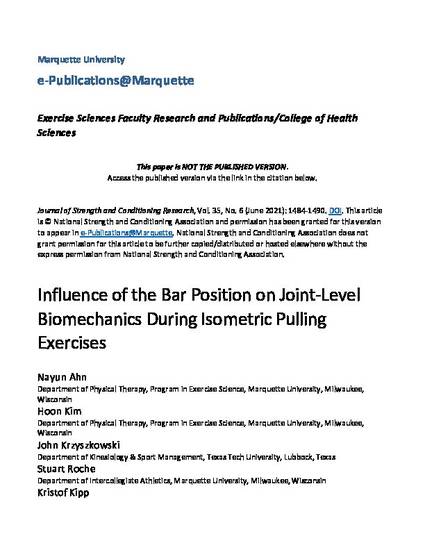
The purpose of this study was to investigate the influence of the bar position on ankle, knee, and hip net joint moments (NJMs), relative muscular effort (RME), and vertical ground reaction forces (GRFs) during isometric pulling exercises, such as the isometric midthigh pull. Eight female lacrosse athletes performed maximal effort isometric pulls at 3 different bar positions (low: above patella, mid: midthigh, and high: crease of hip) while motion capture and GRF data were recorded. Net joint moments were calculated with inverse dynamics. Relative muscle effort was defined as the ratio between the inverse dynamics NJMs and the maximum theoretical NJMs, which were estimated with regression-based maximum moment-angle models. Peak NJM and RME were compared with 2-way analyses of variance (ANOVA), whereas GRFS were compared with a 1-way ANOVA. Peak vertical GRF were significantly greater in the mid bar position than the high bar position but did not differ between the low and mid bar position. Bar position significantly influenced peak hip and knee NJM and RME. Hip NJM and RME were greatest in the low bar position, whereas knee NJM and RME were greater in the mid bar position. Because hip and knee extensor NJM and RME differed between the low and mid bar positions, but the GRFS did not, the joint-specific contributions to peak isometric pulling forces likely reflected a trade-off between hip dominance and knee dominance in the low and mid bar position, respectively. This information should be considered in the interpretation isometric pulling data and their use in assessing and monitoring maximal force-producing capacity of the lower body.
Available at: http://works.bepress.com/kristof-kipp/23/
Accepted version. Journal of Strength and Conditioning Research, Vol. 35, No. 6 (June 2021): 1484-1490. DOI. © 2021 National Strength and Conditioning Association. Used with permission.